杨云,许光旭,励建安,等.江苏省社区脊髓损伤人群就业情况横断面观察研究[J].中华物理医学与康复杂志,2020,42(5):446-453
扫码阅读全文

|
| 江苏省社区脊髓损伤人群就业情况横断面观察研究 |
|
| |
| DOI:10.3760/cma.j.issn.0254-1424.2020.05.016 |
| 中文关键词: 脊髓损伤 社区调查 国际功能、残疾和健康分类 就业 横断面研究 |
| 英文关键词: Spinal cord injury Community surveys International Classification of Functioning, Disabi-lity and Health Employment Cross-sectional studies |
| 基金项目:国际脊髓损伤调查-中国江苏(ChiCTR1800018559) |
|
| 摘要点击次数: 5485 |
| 全文下载次数: 6317 |
| 中文摘要: |
| 目的 从个人相关因素、身体功能、活动能力和环境因素等方面了解江苏省内居住于社区的脊髓损伤(SCI)患者的就业情况,从而确定影响其伤后就业的因素,并从不同方面提出脊髓损伤患者回归工作岗位的潜在方法。 方法 本研究为横断面观察性研究,基于国际脊髓损伤(InSCI)社区调查—中国江苏项目,以国际功能、残疾和健康分类(ICF)为框架,以问卷调查的形式收集患者的相关数据。社区调查问卷内容涉及社会人口学资料、疾病相关资料、身体功能、活动和参与、环境因素、总体健康和幸福感评价等方面。应用描述性统计分析脊髓损伤患者的就业相关基本情况,应用单因素与多因素Logistic回归方法分析社区脊髓损伤患者就业的影响因素。 结果 2018年1月至12月,共收集问卷726份,其中541份通过电话访谈、152份通过网络链接以及33份通过面对面访谈形式完成。Logistic回归结果可知,在家/外出时是否有人照顾(OR=0.405)、损伤时年龄(OR=0.949)、个人因素(OR=1.068)、活动和参与(OR=1.034)以及环境因素(OR=1.043)是影响脊髓损伤患者从事带薪职业的主要因素(P<0.05)。 结论 居住在社区的脊髓损伤患者就业率较低(22.80%),活动受限和环境障碍为影响其就业的主要因素。全面的康复方案的制定与实施,足够的家庭与社会支持将有助于患者重回工作岗位。 |
| 英文摘要: |
| Objective To learn about the employment situation of community-dwelling spinal cord injury (SCI ) survivors in Jiangsu Province and the factors which influence it, aiming to put forward suggestions which can help them return to work. Methods This cross-sectional observational study was based on a International Spinal Cord Injury (InSCI) community survey in Jiangsu Province using a questionnaire (InSCI questionnaire) devloped with the International Classification of Functioning, Disability and Health as the framework. Data were collected using the InSCI questionnaire. Data on sociodemographics, diseases, body functions, activities and participation, environmental factors, general health, well-being and so on were collected. Descriptive statistics were computed to analyze the respondents′ employment-related information. Correlation analysis and multiple linear regression were used to analyze factors influencing the employment of these community-dwelling SCI survivors. Results From January to December of 2018, 726 completed questionnaires were collected-541 through telephone interviews, 152 via Internet links and 33 via face-to-face interviews. Logistic regression showed that residential patterns (odds ratio, OR=0.472), whether there was someone to take care of them at home or going out (OR=0.405), age at the onset of injury (OR=0.949), personal factors (OR=1.068), activity and participation (OR=1.034), and environmental factors (OR=1.043) all influenced the respondents′ engaging in paid work. Conclusion The employment rate of patients with spinal cord injury living in the community is low (22.8%). Comprehensive rehabilitation programs and adequate family and social support should be implemented to help them return to work. |
|
查看全文
查看/发表评论 下载PDF阅读器 |
| 关闭 |
|
|
|